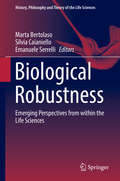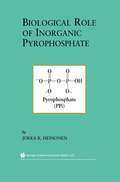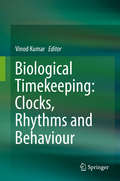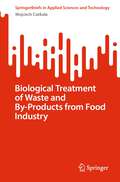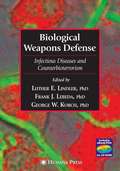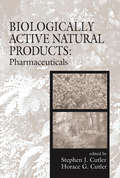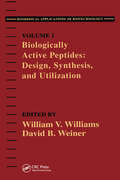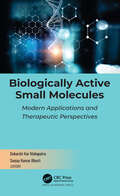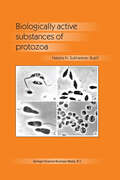- Table View
- List View
Biological Reactive Intermediates Vi: Chemical and Biological Mechanisms in Susceptibility to and Prevention of Environmental Diseases (pdf) (Advances in Experimental Medicine and Biology #500)
by Robert R. Snyder Terrence J. Monks David J. Jollow I. Glenn Sipes Helmut Greim G. Gordon Gibson Marcel Delaforge Patrick M. DansetteBiological Response Modifiers — Interferons, Double-Stranded RNA and 2′,5′-Oligoadenylates (Progress in Molecular and Subcellular Biology #14)
by W. E. G. Müller H. C. SchröderBiological response modifiers are increasingly used in viral and cancer therapy. Since alterations of the immune system are the primary symptoms of HIV infection, especially therapies directed towards the modulation of the immune response have been under intense evaluation. This volume summarizes current knowledge of the interferon-based natural antiviral protection system including 2',5'-oligoadenylate and double-stranded RNA. It will also help to develop further a solid scientific rationale for the practical use of heterologous immunomodulators in the clinics.
Biological Response Modifiers in Human Oncology and Immunology (Advances in Experimental Medicine and Biology #166)
by Andor SzentivanyiThe topic of biological response modifiers has attracted the attention of many biomedical investigators, including immunologists, oncologists, pharmacologists, microbiologists, and biochemists, as well as clinical practitioners of medicine. This has occurred mainly because of the realization that the complex system of cellular and humoral interactions culminating in a productive immune response is under exquisite regulatory control for normal immune responses and that loss of control may markedly influence the capability of a host to respond in a productive manner to the numerous immunologic "insults" encountered in the environment. Furthermore, biological response modification is considered by many to be a natural offshoot of the relatively new application of "immunotherapy" to cancer. It is widely recognized that "immunotherapy" was practiced at the end of the last century and the beginning of this century when it was recognized that microbial infections were caused by distinct species of bacteria and that passive administration of serum con taining antibody to these microbes or their products could, in many cases, favorably influence the outcome of an infectious process.
Biological Responses in Cancer: Progress toward Potential Applications Volume 2
by EnricoMihichThe series of volumes entitled Biological Responses in Cancer: Progress toward Potential Applications provides information on approaches through which the interaction between neoplastic and normal cells may be modified. Each annual volume contains contributions in areas where significant prog ress has been made. Topics to be dealt with include immunologic and host defense systems, control mechanisms of cell and population growth, cell differentiation, and cell transformation. The regulatory mechanisms controlling the interactions between normal and tumor cells may be immunologic in nature or they may relate to diverse biological characteristics of tumor and normal cells and their response to micro environmental factors. While the central question of tumor immunol ogy addresses the nature and uniqueness of tumor-associated antigens in humans, the identification of the stages of differentiation and functions of the various cell types involved in immunity is advancing rapidly. The de velopment of monoclonal antibody methodologies, together with progress in the biochemical characterization of cell markers, cell separation, and measurement of cell functions, has significantly aided in the identification and quantitation of different cell types. Establishing the role of these cells in the regulation of human immune mechanisms offers a means for evalu ating the status of the immune responses in cancer patients and for assessing the effects that tumor and antitumor treatments may exert on their func tionality, which, in turn, may alter the effects of antitumor treatments.
Biological Responses in Cancer
by Enrico MihichThe series of volumes entitled Biological Responses in Cancer provides information on approaches through which the interaction between neoplas tic and normal cells may be modified. Topics discussed in various volumes include immunological and host defense systems, control mechanisms of cell and population growth, cell differentiation, and cell transformation. This volume is specifically concerned with various aspects of cell interactions and regulation within heterogeneous tumor cell populations, and their role in tumor progression and metastasis. Knowledge in this area is likely to provide new leads toward the exploitation of novel cellular sites and mech anisms in the development of new types of therapies of cancer. Several topics are discussed within these general areas of consideration. The possibly unique characteristics and mechanisms of tumor vascularization and the potential sites of interference with angiogenesis that might have therapeutic impli cations are critically evaluated. Tumor cell-normal tissue interactions in volved in different phases of the growth and metastatic processes are dis cussed in two chapters dealing with mechanisms of tumor invasion and with the role of collagen in mammary tumor growth; here again potential leads are identified that may be exploited toward the development of new thera peutic approaches. The evolution of phenotypic diversity as a phenomenon complicating the biology of tumor metastasis and consequently affecting the opportunities offered by chemotherapy is also critically considered.
Biological Rhythms
by Vinod Kumar(Chapters 11 to 14) summarise important features of the biological clock at the level of whole animal covering all vertebrate classes (fish to mammal). Chapters 15 and 16 are on long term (seasonal) rhythms in plants and higher vertebrates. Short term rhythms (ultradian rhythms), the significance of having a clock system in animals living in extreme (arctic) environments, and the diversity of circadian responses to melatonin, the key endocrine element involved in regulation of biological rhythms, have been discussed in Chapters 17 to 19. Finally, a chapter on sensitivity to light of the photoperiodic clock is added which, using vertebrate examples, illustrates the importance of wavelength and intensity of light on circadian and non-circadian functions. A well-known expert writes each chapter. When presenting information, the text provides consistent thematic coverage and feeling for the methods of investigation. Reference citation within the body of the text adequately reflects the literature as subject is developed. A chapter begins with an abstract that enables a reader to know at the first glance the important points covered in that chapter. The chapter concludes with a full citation of references included in the text, which could be useful for further reading. The book ends with a comprehensive subject index that may be useful for quick searches.
Biological Rhythms and Endocrine Function (Advances in Experimental Medicine and Biology #54)
by Laurence HedlundThese Proceedinqs of the Midwest Conference on Endocrinology and Metabolism are being published by Plenum Press for the first time. Earlier Proceedings in the series Vlere published by the University of Missouri at Columbia. The shift to an internationally recognized pub lisher reflects the considerable growth in stature that the Midwest Con ferences have undergone since their inception nine years ago. Originally concerned only with the endocrinology of the thyroid, the Conferences now explore other endocrine areas. Efforts are made to assemble a panel of speakers selected from different sub-disciplines within endocrinology for the purpose of addressing a common problem. The Ninth Conference typifi es til i s approach. The format used in recent Conferences is not unique, but is unfor tunately encountered too rarely. A few prominent scholars are invited to come together to expound their findings and concepts in considerable depth, and to participate in a discussion which, together with the for mal presentation, is published in the Proceedings. The discussion, noted for its unhurried nature, permits wide participation by the audi ence. The subject of the Ninth Conference is one which is basic and im portant not only to endocrinology but also to biology in general. Many, possibly most, life processes change in a rhythmic fashion, with similar states recurring at regular time intervals. This rhythmic property of living systems expresses itself as a recognizable and definable pattern or "time-form" in a manner equivalent to the more customary spatial form.
Biological Rhythms and Medicine: Cellular, Metabolic, Physiopathologic, and Pharmacologic Aspects (Topics in Environmental Physiology and Medicine)
by A. Reinberg M. H. SmolenskyDuring the past decade many review papers and books have been devoted to descriptions and analyses of biological rhythms (chronobiology) in plants and animals. These contributed greatly to demonstrating the impor tance of bioperiodicities in living beings in general. However, the practi cal aspects of chronobiology with regard to human health and improving the treatment of disease have not yet been a major focus of publication. One of our aims is to establish the relevance of biological rhythms to the practice of medicine. Another is to organize and convey in a simple fashion information pertinent to health- and life-science professionals so that students, researchers, and practitioners can achieve a clear and pre cise understanding of chronobiology. We have limited scientific jargon to unavoidable basic and well-defined terms and we have emphasized illus trative examples of facts and concepts rather than theories or hypotheti cal mechanisms. This volume is divided into seven chapters, each of which is compre hensive in its treatment and includes an extensive bibliography. The book is organized to serve as a textbook and/or reference handbook of modem applied chronobiology. Chapter 1 describes the historical development of chronobiology and reviews why, when, and how major concepts were introduced, accepted, and transformed.
Biological Robustness: Emerging Perspectives from within the Life Sciences (History, Philosophy and Theory of the Life Sciences #23)
by Marta Bertolaso Silvia Caianiello Emanuele SerrelliThis volume reviews examples and notions of robustness at several levels of biological organization. It tackles many philosophical and conceptual issues and casts an outlook on the future challenges of robustness studies in the context of a practice-oriented philosophy of science. The focus of discussion is on concrete case studies. These highlight the necessity of a level-dependent description of robust biological behaviors.Experts from the neurosciences, biochemistry, ecology, biology, and the history and the philosophy of life sciences provide a multiplex perspective on the topic. Contributions span from protein folding, to cell-level robustness, to organismal and developmental robustness, to sensorimotor systems, up to the robustness of ecological systems.Several chapters detail neurobiological case-studies. The brain, the poster child of plasticity in biology, offers multiple examples of robustness. Neurobiology explores the importance of temporal organization and multiscalarity in making this robustness-with-plasticity possible. The discussion also includes structures well beyond the brain, such as muscles and the complex feedback loops involved in the peculiar robustness of music perception. Overall, the volume grounds general reflections upon concrete case studies, opening to all the life sciences but also to non-biological and bio-inspired fields such as post-modern engineering. It will appeal to researchers, students, as well as non-expert readers.
Biological Role of Inorganic Pyrophosphate
by Jukka K. HeinonenDr. Heinonen reviews and critically evaluates the scientific literature on the biological role of inorganic pyrophosphate (PPi ) published from 1940 to the end of 1999. He describes and classifies all known biochemical reactions that produce Ppi; describes and evaluates all published methods used in biological Ppi; and compiles and critically evaluates information on the concentration of PPi (with the conclusion that, contrary to common belief, PPi exists throughout the living world in rather high concentrations). Many reactions in which PPi is used as a biochemical energy source instead of ATP have been described in recent decades, especially in bacteria, protists, and plants. These reactions are evaluated from the bioenergetic and regulatory points of view. Also considered is the possible role of PPi as a source of biochemical energy in the primitive phases of life, before ATP. Data is presented on the regulatory role of PPi in living systems, such as activities of enzymes, fidelity of syntheses of macromolecules, and proliferation of cells. PPi may also regulate the formation and dissolution of bone as well as pathologic calcification of soft tissues and the formation of urinary stones. The formation of calcium pyrophosphate dihydrate crystals in the extracellular fluids of joints cause the disease called pseudogout. Biological Role of Inorganic Pyrophosphate book is a unique and invaluable source of references (about 1120) and summarized data for professionals who study or plan to study the role of PPi in living systems. Many different branches of science (biochemistry, microbiology, bioenergetics, plant physiology, parasitology, evolution, orthopedics, rheumatology) have involvement with PPi. This book sums up available knowledge in one place and will help scientists cross disciplinary boundaries.
Biological Signal Transduction (Nato ASI Subseries H: #52)
by Elliott M. Ross Karel W. A. WirtzProceedings of the NATO Advanced Research Institute on Biological Signal Transduction held on the Island of Spetsai (Greece), August 6 - 17, 1990
Biological Signals Classification and Analysis (Lecture Notes in Bioengineering)
by Kamran KiasalehThis authored monograph presents key aspects of signal processing analysis in the biomedical arena. Unlike wireless communication systems, biological entities produce signals with underlying nonlinear, chaotic nature that elude classification using the standard signal processing techniques, which have been developed over the past several decades for dealing primarily with standard communication systems. This book separates what is random from that which appears to be random and yet is truly deterministic with random appearance. At its core, this work gives the reader a perspective on biomedical signals and the means to classify and process such signals. In particular, a review of random processes along with means to assess the behavior of random signals is also provided. The book also includes a general discussion of biological signals in order to demonstrate the inefficacy of the well-known techniques to correctly extract meaningful information from such signals. Finally, a thorough discussion of recently proposed signal processing tools and methods for addressing biological signals is included. The target audience primarily comprises researchers and expert practitioners but the book may also be beneficial for graduate students.
Biological Synthesis of Nanoparticles and Their Applications
by L. Karthik A. Vishnu Kirthi Shivendu Ranjan V. Mohana SrinivasanBiological Synthesis of Nanoparticles and Their Applications gives insight into the synthesis of nanoparticles utilizing the natural routes. It demonstrates various strategies for the synthesis of nanoparticles utilizing plants, microscopic organisms like bacteria, fungi, algae and so forth. It orchestrates interdisciplinary hypothesis, ideas, definitions, models and discoveries associated with complex cell of the prokaryotes and eukaryotes. Highlights: Discusses biological approach towards the nanoparticle synthesis Describes the role of nanotechnology in the field of medicine and its medical devices Covers application and usage of the chemicals at the molecular level to act as catalysts and binding products for both organic and inorganic Chemical Reactions Reviews application in physics such as solar cells, photovoltaics and other usage Microorganisms can aggregate and detoxify substantial metals because of different reductase enzymes, which can diminish metal salts to metal nanoparticles. The readers after going through this book will have detailed account of mechanism of bio-synthesis of nanoparticles.
Biological Synthesis of Nanoparticles and Their Applications
by L. Karthik A. Vishnu Kirthi Shivendu Ranjan V. Mohana SrinivasanBiological Synthesis of Nanoparticles and Their Applications gives insight into the synthesis of nanoparticles utilizing the natural routes. It demonstrates various strategies for the synthesis of nanoparticles utilizing plants, microscopic organisms like bacteria, fungi, algae and so forth. It orchestrates interdisciplinary hypothesis, ideas, definitions, models and discoveries associated with complex cell of the prokaryotes and eukaryotes. Highlights: Discusses biological approach towards the nanoparticle synthesis Describes the role of nanotechnology in the field of medicine and its medical devices Covers application and usage of the chemicals at the molecular level to act as catalysts and binding products for both organic and inorganic Chemical Reactions Reviews application in physics such as solar cells, photovoltaics and other usage Microorganisms can aggregate and detoxify substantial metals because of different reductase enzymes, which can diminish metal salts to metal nanoparticles. The readers after going through this book will have detailed account of mechanism of bio-synthesis of nanoparticles.
Biological Timekeeping: Clocks, Rhythms and Behaviour
by Vinod KumarThis book is a concise, comprehensive and up-to-date account of fundamental concepts and potential applications of biological timekeeping mechanisms in animals and humans. It also discusses significant aspects of the organization and importance of timekeeping mechanisms in both groups. Divided into seven sections, it addresses important aspects including fundamental concepts; animal and human clocks; clock interactions; clocks and metabolism and immune functions; pineal, melatonin and timekeeping; and clocks, photoperiodism and seasonal behaviours. The book also focuses on biological clock applications in a 24x7 human society, particularly in connection with life-style associated disorders like obesity and diabetes. It is a valuable resource for advanced undergraduates, researchers and professionals engaged in the study of the science of biological timekeeping.
Biological Toxins and Bioterrorism (Toxinology Ser. #1)
by P. Gopalakrishnakone Mahdi Balali-Mood Lyndon Llewellyn Bal Ram SinghBiological toxins are an important part of our world, a reality with which we need to cope, so in parallel with understanding their mechanisms of action and thereby improving our fundamental knowledge, there are successful efforts to utilize them as therapeutics against some debilitating human and animal diseases. In view of the complexity of different types of biotoxins and the broad range of toxin structure, physiology, utility, and countermeasures including regulatory issues, it was thus aimed to compile a book on biotoxins and bioweapons. ℗ℓ This reference work in the Toxinology handbook series gathers together knowledge from around the globe about naturally inspired and manufactured biological weapons. The authors describe how they work; how authorities may detect their presence, prevent their use, and diagnose their impacts; and the means by which medical and paramedical professionals may treat victims. Also described are how they have been used to further our knowledge and what insights they have given us into evolutionary and physiological processes. Finally, it is also discussed how these toxins can be used as therapeutics and what the implications of such therapeutics are to their use as biothreat agents. ℗ℓ This volume provides a reference accessible to scientists, educators, and medical experts alike with an interest in biotoxins, focusing on the major toxins used as bioweapons. Regulatory agencies will also beneƠ̐ℓt from the information provided in this book. Some in the intended audience may need to understand how they elicit their effects and how we can defend ourselves against them. Others may be interested in the sometimes colorful histories that surround this subset of biotoxins that can be and, in some cases, have been used as weapons.
Biological Treatment of Waste and By-Products from Food Industry (SpringerBriefs in Applied Sciences and Technology)
by Wojciech CzekałaThis book discusses selected waste and by-products of the food industry. Two commonly used methods of managing these are discussed: anaerobic digestion and composting. The book reviews current research and also brings in the author’s own research insights to the discussion. The book is aimed at food industry specialists, waste management specialists, scientists, and students. However, the book describes problems in an accessible way, which will make this book useful for beginners in the waste/biogas/composting sector.
Biological Weapons Defense: Infectious Disease and Counterbioterrorism (Infectious Disease)
by Luther E. Lindler Frank J. Lebeda George KorchIn 2003, the President’s budget for bioterrorism defense totalled more than $5 billion. Today, the nation’s top academic scientists are scrambling to begin work to understand Bacillus anthracis and develop new vaccines and drugs. However, just five years ago, only the US Department of Defense (DOD) seemed concerned about these “exotic” agents. In 1997, the DOD spent approximately $137 million on biodefense to protect the deployed force, while academe, industry, local governments, and most of our federal leadership was oblivious to, and in some cases doubtful of, the seriousness of the threat. The National Institutes of Health (NIH) received the largest budget increase in the organization’s history. Fortunately, during this time of national urgency, a sound base exists on which to build our defenses against this new threat. A relatively small cadre of dedicated scientists within the US Army Medical Research and Materiel Command (USAMRMC) laid this foundation over the past 20 years.
Biologically Active Natural Products: Pharmaceuticals
by Stephen J. Cutler Horace G. CutlerBiologically Active Natural Products: Pharmaceuticals demonstrates the connections between agrochemicals and pharmaceuticals and explores the use of plants and plant products in the formulation and development of pharmaceuticals. Experts from around the world examine a multitude of topics, including evaluation of extracts from tropical plants for p
Biologically Active Peptides: Design, Synthesis and Utilization
by David B. Weiner William V. WilliamsInvestigation into basic and advanced peptide design, synthesis, evaluation and utilization. New therapeutic approaches from experimental systems.
Biologically Active Peptides: Design, Synthesis and Utilization
by David B. Weiner William V. WilliamsInvestigation into basic and advanced peptide design, synthesis, evaluation and utilization. New therapeutic approaches from experimental systems.
Biologically Active Small Molecules: Modern Applications and Therapeutic Perspectives
by Debarshi Kar Mahapatra Sanjay Kumar BhartiBiologically Active Small Molecules: Modern Applications and Therapeutic Perspectives focuses on small molecules as active pharmacological agents, their pharmacotherapeutically active properties, new approaches in drug discovery using small molecules, and biopharmaceutic approaches for low molecular weight ligands. Molecules of low mass play a pivotal role in pharmacology because they exhibit multifarious pharmacological effects. Small molecules have become universally popular due to their simple chemistry, easy separation techniques, versatile acceptance for computational studies, large number of places for the substitution of active chemical moieties by well-established synthetic routes with less effort, better quality attributes, and ability to demonstrate numerous biological activities. This book provides a multidisciplinary approach that delivers the most updated knowledge and advances of some newly developed therapeutically active low molecular weight compounds. It includes chapters that present up-to-date and concise content on the classification, structures, chemical syntheses, medicinal chemistry, pharmacology, biochemical pathways, mechanism of actions, side effects, and adverse effects of small molecule drug discovery. The book covers a broad area by highlighting the advances of inter- and multidisciplinary fields of medicine, chemical sciences, and pharmaceuticals. The flowcharts, figures, illustrations, and diagrams provide important information and will be of great interest for readers.
Biologically Active Small Molecules: Modern Applications and Therapeutic Perspectives
by Debarshi Kar Mahapatra Sanjay Kumar BhartiBiologically Active Small Molecules: Modern Applications and Therapeutic Perspectives focuses on small molecules as active pharmacological agents, their pharmacotherapeutically active properties, new approaches in drug discovery using small molecules, and biopharmaceutic approaches for low molecular weight ligands. Molecules of low mass play a pivotal role in pharmacology because they exhibit multifarious pharmacological effects. Small molecules have become universally popular due to their simple chemistry, easy separation techniques, versatile acceptance for computational studies, large number of places for the substitution of active chemical moieties by well-established synthetic routes with less effort, better quality attributes, and ability to demonstrate numerous biological activities. This book provides a multidisciplinary approach that delivers the most updated knowledge and advances of some newly developed therapeutically active low molecular weight compounds. It includes chapters that present up-to-date and concise content on the classification, structures, chemical syntheses, medicinal chemistry, pharmacology, biochemical pathways, mechanism of actions, side effects, and adverse effects of small molecule drug discovery. The book covers a broad area by highlighting the advances of inter- and multidisciplinary fields of medicine, chemical sciences, and pharmaceuticals. The flowcharts, figures, illustrations, and diagrams provide important information and will be of great interest for readers.
Biologically Active Substances of Protozoa
by N.N. Sukhareva-BuellThe search for new producers of biologically active substances (BAS) against human and animal diseases continues to be an important task in biology and medicine. Experimental work must be carried out well in advance of need because it takes an average of ten years to develop a new medication, as well as additional time to put it on the market. Study of the Protozoa forms a special branch of biology - protozoology. The traditional fields of protozoology are taxonomy, phylogeny, morphology, cytology, evolution, ecology and host parasite-interactions. The Protozoa is the only taxon among the microscopic organisms, which has not been persistently studied as a source of BAS. This book then is the result of the research on the project: "Biologically active substances of the Mastigophora (Flagellates)". The research was carried out at the Laboratory of Antibiotics, Department of Microbiology, Biological Faculty of Moscow State University. Articles of other authors on the matter have been considered as the important part of this reference book. The goal of the reference book is to elucidate scientific approaches, which lead to obtaining biologically active substances from cultures of protozoa; the book reviews the historical background in connection with contemporary development of the field. N.N. Sukhareva ACKNOWLEDGMENTS The research was performed in fruitful cooperation with my research associates (V. Urinyuk, T. Titiova, L. Udalova, R. Zeleneva, V. Brusovanik, M. Zaretskaya), postgraduate students (N. Kalenik, M. Chuenkova, V. Vasilevskaya, V. Khorokhorina), my colleagues at Moscow State University (Yu. Kozlov and I.
Biologically Based Methods for Cancer Risk Assessment (Nato Science Series A: #159)
by Curtis Travis"Biologically Based Methods for Cancer Risk Assessment", an Advanced Research Workshop, (ARW) sponsored by the North Atlantic Treaty Organization (NATO) was held in Corfu, Greece in June, 1989. The intent of the workshop was to survey available pharmacokinetic and pharmacodynamic methods in cancer risk assessment and identify methodological gaps and research needs for biologically based methods in cancer risk assessment. Incorporation of such methods represents one of the most challenging areas for risk assessment. The workshop included an international group of invited experts in the field and provided for a dynamic exchange of ideas and accomplishments. Some of the major topics discussed were: * Inventory of available pharmacokinetic and pharmacodynamic methods for cancer risk assessment. * Identification of methodology gaps and research needs in biologically based methods in cancer risk assessment. * Development of a general framework to guide future cancer risk assessment research. This book is a compilation of the papers presented at the workshop and is intended to provide guidance for future research to reduce uncertainties in the cancer risk assessment process. The primary sponsorship of this ARW by NATO and the advice and cooperation of Dr. C. Sinclair of the Scientific affairs Division are gratefully acknowledged. Acknowledgement is also given to the National Science Foundation for its support. The organization of the ARW and the preparation of this book have required considerable help from many other sources.








